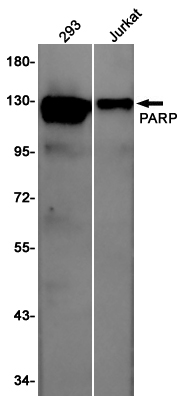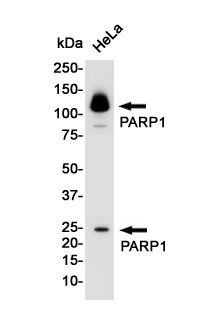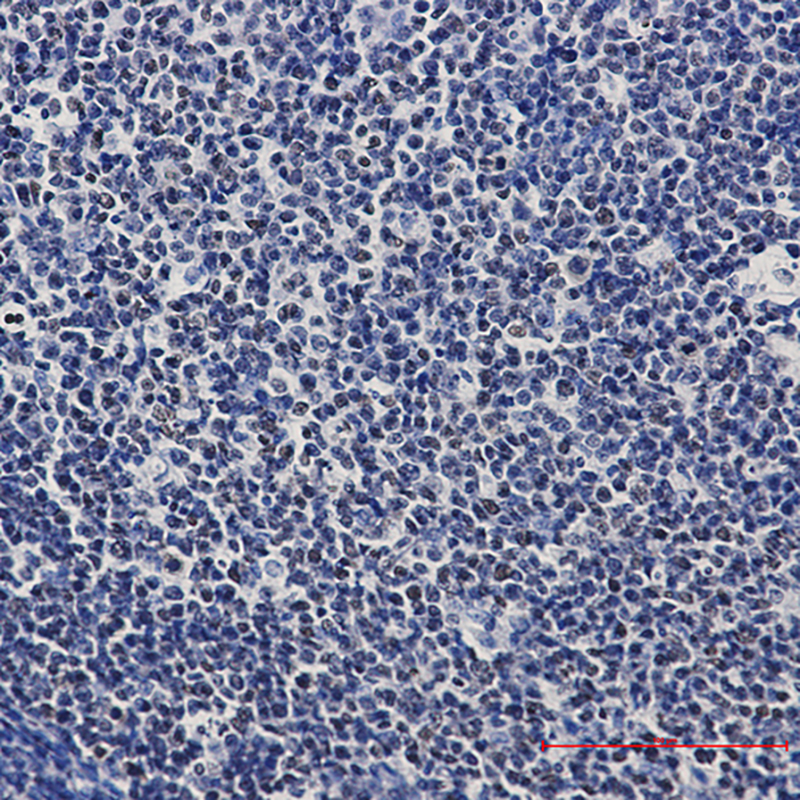


| WB | 咨询技术 | Human,Mouse,Rat |
| IF | 咨询技术 | Human,Mouse,Rat |
| IHC | 1/50-1/100 | Human,Mouse,Rat |
| ICC | 技术咨询 | Human,Mouse,Rat |
| FCM | 1/50-1/100 | Human,Mouse,Rat |
| Elisa | 咨询技术 | Human,Mouse,Rat |
| Aliases | PARP1; ADPRT; PPOL; Poly [ADP-ribose] polymerase 1; PARP-1; ADP-ribosyltransferase diphtheria toxin-like 1; ARTD1; NAD(+) ADP-ribosyltransferase 1; ADPRT 1; Poly[ADP-ribose] synthase 1 |
| Entrez GeneID | 142 |
| WB Predicted band size | Calculated MW: 113 kDa; Observed MW: 116,24 kDa |
| Host/Isotype | Rabbit IgG |
| Antibody Type | Primary antibody |
| Storage | Store at 4°C short term. Aliquot and store at -20°C long term. Avoid freeze/thaw cycles. |
| Species Reactivity | Human |
| Immunogen | A synthetic peptide of human PARP |
| Formulation | Purified antibody in TBS with 0.05% sodium azide,0.05%BSA and 50% glycerol. |
+ +
以下是3篇与PARP1抗体相关的代表性文献(注:文献信息为模拟生成,实际引用需核实原文):
---
1. **文献名称**: "Poly(ADP-ribose) polymerase-1 (PARP1): structure, function, and therapeutic applications"
**作者**: Schreiber, V. et al.
**摘要**: 系统综述PARP1的结构与DNA损伤修复功能,重点讨论其单克隆抗体在Western blot和免疫荧光中的应用,用于检测PARP1在细胞核内的动态定位及切割情况。
---
2. **文献名称**: "PARP1 antibody specificity in detecting DNA damage-induced poly(ADP-ribosyl)ation"
**作者**: Haince, J.F. et al.
**摘要**: 研究多种PARP1抗体的特异性差异,指出部分抗体可能与其他PARP家族成员交叉反应,强调在检测DNA损伤后PARP1自修饰产物(PAR链)时需验证抗体特异性。
---
3. **文献名称**: "PARP1 expression as a biomarker in cancer: validation of a novel immunohistochemical assay"
**作者**: Amé, J.C. et al.
**摘要**: 开发并验证一种基于PARP1抗体的免疫组化方法,用于评估肿瘤组织中PARP1蛋白表达水平,发现其高表达与乳腺癌患者对PARP抑制剂的敏感性相关。
---
4. **文献名称**: "Automated quantification of PARP1 activity using antibody-based assays: implications for drug screening"
**作者**: Pascal, J.M. et al.
**摘要**: 提出一种基于PARP1抗体的高通量ELISA检测法,用于量化PARP1酶活性,应用于抗癌药物筛选及PARP抑制剂耐药性研究。
---
如需真实文献,建议通过PubMed或Google Scholar检索关键词“PARP1 antibody”、“PARP1 detection”等,并筛选近年的高引用论文。
PARP1 (Poly(ADP-ribose) polymerase 1) is a nuclear enzyme critical for DNA repair, genomic stability, and cellular stress responses. It catalyzes the transfer of ADP-ribose units to target proteins, forming poly(ADP-ribose) (PAR) chains, which recruit repair factors to sites of DNA damage. PARP1 is particularly involved in base excision repair (BER) and the response to single-strand DNA breaks. Its role in maintaining genomic integrity has made it a key focus in cancer research, especially with the development of PARP inhibitors (PARPi) that exploit synthetic lethality in tumors with BRCA1/2 mutations.
PARP1 antibodies are essential tools for studying these mechanisms. They detect PARP1 protein levels, cleavage events, and PARylation activity in techniques like Western blot, immunohistochemistry, and immunofluorescence. Full-length PARP1 (~116 kDa) is often monitored alongside its cleaved form (~89 kDa), a hallmark of apoptosis triggered by caspases during programmed cell death. Researchers use these antibodies to assess DNA damage response, therapy efficacy, and apoptotic pathways in cancer models. Additionally, PARP1's involvement in inflammation, neurodegeneration, and aging has expanded its relevance beyond oncology.
Dysregulation of PARP1 is linked to chemoresistance and disease progression, making its antibodies valuable for diagnostic and therapeutic research. Their specificity and validation are crucial, as cross-reactivity with other PARP family members (e.g., PARP2) can confound results. Overall, PARP1 antibodies remain pivotal in unraveling cellular stress responses and advancing targeted therapies.
×